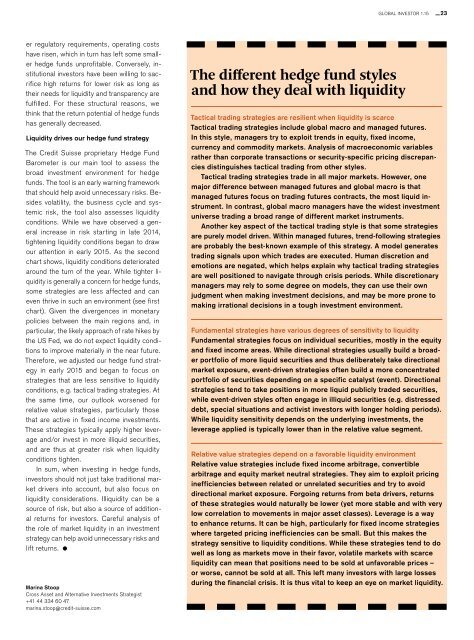Illiquid assets
Unwrapping alternative returns Global Investor, 01/2015 Credit Suisse
Unwrapping alternative returns
Global Investor, 01/2015
Credit Suisse
Create successful ePaper yourself
Turn your PDF publications into a flip-book with our unique Google optimized e-Paper software.
GLOBAL INVESTOR 1.15 — 23<br />
er regulatory requirements, operating costs<br />
have risen, which in turn has left some smaller<br />
hedge funds unprofitable. Conversely, institutional<br />
investors have been willing to sacrifice<br />
high returns for lower risk as long as<br />
their needs for liquidity and transparency are<br />
fulfilled. For these structural reasons, we<br />
think that the return potential of hedge funds<br />
has generally decreased.<br />
Liquidity drives our hedge fund strategy<br />
The Credit Suisse proprietary Hedge Fund<br />
Barometer is our main tool to assess the<br />
broad investment environment for hedge<br />
funds. The tool is an early warning framework<br />
that should help avoid unnecessary risks. Besides<br />
volatility, the business cycle and systemic<br />
risk, the tool also assesses liquidity<br />
conditions. While we have observed a general<br />
increase in risk starting in late 2014,<br />
tightening liquidity conditions began to draw<br />
our attention in early 2015. As the second<br />
chart shows, liquidity conditions deteriorated<br />
around the turn of the year. While tighter liquidity<br />
is generally a concern for hedge funds,<br />
some strategies are less affected and can<br />
even thrive in such an environment (see first<br />
chart). Given the divergences in monetary<br />
policies between the main regions and, in<br />
particular, the likely approach of rate hikes by<br />
the US Fed, we do not expect liquidity conditions<br />
to improve materially in the near future.<br />
Therefore, we adjusted our hedge fund strategy<br />
in early 2015 and began to focus on<br />
strategies that are less sensitive to liquidity<br />
conditions, e.g. tactical trading strategies. At<br />
the same time, our outlook worsened for<br />
relative value strategies, particularly those<br />
that are active in fixed income investments.<br />
These strategies typically apply higher leverage<br />
and/or invest in more illiquid securities,<br />
and are thus at greater risk when liquidity<br />
conditions tighten.<br />
In sum, when investing in hedge funds,<br />
investors should not just take traditional market<br />
drivers into account, but also focus on<br />
liquidity considerations. <strong>Illiquid</strong>ity can be a<br />
source of risk, but also a source of additional<br />
returns for investors. Careful analysis of<br />
the role of market liquidity in an investment<br />
strategy can help avoid unnecessary risks and<br />
lift returns.<br />
Marina Stoop<br />
Cross Asset and Alternative Investments Strategist<br />
+41 44 334 60 47<br />
marina.stoop@credit-suisse.com<br />
The different hedge fund styles<br />
and how they deal with liquidity<br />
Tactical trading strategies are resilient when liquidity is scarce<br />
Tactical trading strategies include global macro and managed futures.<br />
In this style, managers try to exploit trends in equity, fixed income,<br />
currency and commodity markets. Analysis of macroeconomic variables<br />
rather than corporate transactions or security-specific pricing discrepancies<br />
distinguishes tactical trading from other styles.<br />
Tactical trading strategies trade in all major markets. However, one<br />
major difference between managed futures and global macro is that<br />
managed futures focus on trading futures contracts, the most liquid instrument.<br />
In contrast, global macro managers have the widest investment<br />
universe trading a broad range of different market instruments.<br />
Another key aspect of the tactical trading style is that some strategies<br />
are purely model driven. Within managed futures, trend-following strategies<br />
are probably the best-known example of this strategy. A model generates<br />
trading signals upon which trades are executed. Human discretion and<br />
emotions are negated, which helps explain why tactical trading strategies<br />
are well positioned to navigate through crisis periods. While discretionary<br />
managers may rely to some degree on models, they can use their own<br />
judgment when making investment decisions, and may be more prone to<br />
making irrational decisions in a tough investment environment.<br />
Fundamental strategies have various degrees of sensitivity to liquidity<br />
Fundamental strategies focus on individual securities, mostly in the equity<br />
and fixed income areas. While directional strategies usually build a broader<br />
portfolio of more liquid securities and thus deliberately take directional<br />
market exposure, event-driven strategies often build a more concentrated<br />
portfolio of securities depending on a specific catalyst (event). Directional<br />
strategies tend to take positions in more liquid publicly traded securities,<br />
while event-driven styles often engage in illiquid securities (e.g. distressed<br />
debt, special situations and activist investors with longer holding periods).<br />
While liquidity sensitivity depends on the underlying investments, the<br />
leverage applied is typically lower than in the relative value segment.<br />
Relative value strategies depend on a favorable liquidity environment<br />
Relative value strategies include fixed income arbitrage, convertible<br />
arbitrage and equity market neutral strategies. They aim to exploit pricing<br />
inefficiencies between related or unrelated securities and try to avoid<br />
directional market exposure. Forgoing returns from beta drivers, returns<br />
of these strategies would naturally be lower (yet more stable and with very<br />
low correlation to movements in major asset classes). Leverage is a way<br />
to enhance returns. It can be high, particularly for fixed income strategies<br />
where targeted pricing inefficiencies can be small. But this makes the<br />
strategy sensitive to liquidity conditions. While these strategies tend to do<br />
well as long as markets move in their favor, volatile markets with scarce<br />
liquidity can mean that positions need to be sold at unfavorable prices –<br />
or worse, cannot be sold at all. This left many investors with large losses<br />
during the financial crisis. It is thus vital to keep an eye on market liquidity.

















